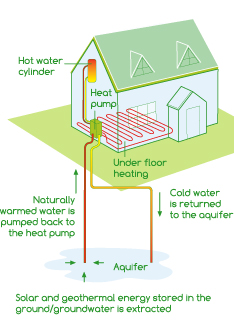
Ground source heat pumps use sustainable energy
 Free sustainable energy is available from the ground and the technology to harness this heat is well proven. The heat obtained is low temperature and ground source heating pump technology uses a small amount of electrical energy to raise the temperature of this extracted heat so that it can be used to produce hot water and to heat buildings and swimming pools.
Free sustainable energy is available from the ground and the technology to harness this heat is well proven. The heat obtained is low temperature and ground source heating pump technology uses a small amount of electrical energy to raise the temperature of this extracted heat so that it can be used to produce hot water and to heat buildings and swimming pools. Heat is extracted from the ground by using heat pumps and a number of different methods, depending on the geology and hydrogeology underlying the site.
Open loop heat pumps
This method relies on harnessing groundwater within a borehole sunk into an aquifer and pumping the water through heat pumps to release the heat for distribution into a building. Once the heat is extracted, the water is returned to the aquifer via the same or a separate borehole or a lake or stream. Efficiencies in excess of 500% are achievable dependant on pumping losses.Closed loop heat pumps
This method relies on placing fluid filled pipes in the ground in horizontal or vertical positions to extract the heat directly from the earth and to release the heat through heat pumps to distribute through a building.A. Horizontal Closed Loop
This is where the pipe is installed in trenches, excavated by machine or by hand, to a depth of at least 1.50m below ground level. The pipe can be laid straight or in a looped manner to reduce the length of the trenches. This system is often used for domestic houses as it is not the most efficient, being only 300% efficient, and is therefore not recommended where large properties require heating. A considerable area of land is also required to ensure consistent heating performance.
B. Vertical Closed Loop
This method requires the pipe to be inserted into vertical boreholes, drilled to the appropriate depth to acquire the heat required. Once the boreholes are drilled to the required depth the geothermal loops are installed, using hydraulically powered loop winders, and filled with antifreeze mix. The antifreeze mix extracts the solar heat absorbed in the ground and the heat from the earth's core. Efficiencies of 400% can be achieved with consistency throughout the seasons and only a small amount of land is required. The loops are spaced apart and thermal grout is mixed and the boreholes are grouted from the base upwards. The thermal grout acts as a conductor between the earth's heat and the fluid in the pipe work. A variation of this system uses a liquid gas to extract the heat from the ground and produces enhanced efficiencies of 500%.
Heat Pumps
Heat pumps operate by absorbing latent heat of evaporation at low pressure and temperature, then emitting latent heat of condensation at high pressure and temperature. To optimize heat pump efficiencies the heating system in the building must be designed efficiently. A heat pump can be reversed and used to cool a building, thus negating the requirement for a separate air conditioning system. Ground Source Heat Pumps are efficient and for every unit of electricity they use to run they produce three or four times the number of units of heat. This saves energy, is cost effective and reduces air pollution. The pumps occupy a small unit indoors and there is no visible sign of the system outdoors.Complete Installation
Ideally the building ventilation system and the heating system should be designed as a single entity. To maximize the heat pump efficiencies and to utilize cheap off peak electrical tariffs, the building should be maintained at a warm temperature by a large thermal mass. An ideal solution is the installation of underfloor heating, a whole building ventilation system with full heat recovery and a geothermal reheat battery for incoming fresh air.The efficiency of heat extraction is paramount in minimizing the electrical consumption of the heating system. The higher the temperature of the extracted heat and the smaller the energy consumed to extract it, the greater the potential efficiency of the heating system.
Most systems come with individual control systems for each room, allowing for rigid control over the temperature of the home. The system is most efficient when it is constantly in operation, which makes it perfect for buildings that require constant temperatures. Installations are suited to houses, apartments, housing estates, swimming pools, schools, police stations, hospitals and government buildings.





